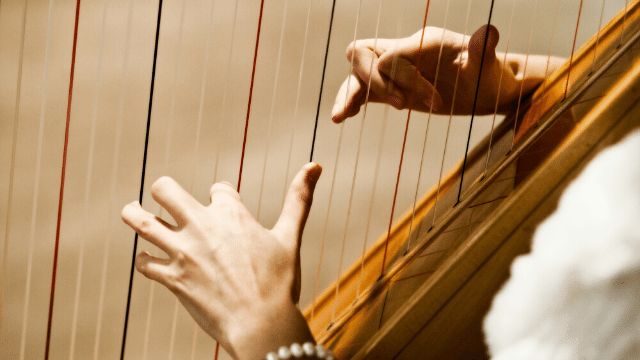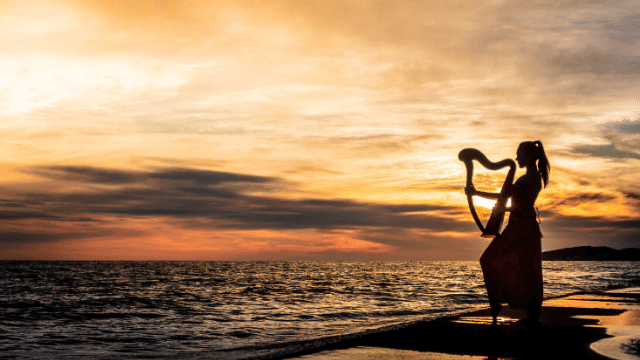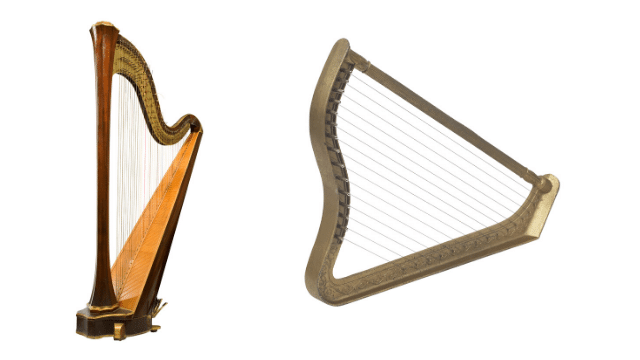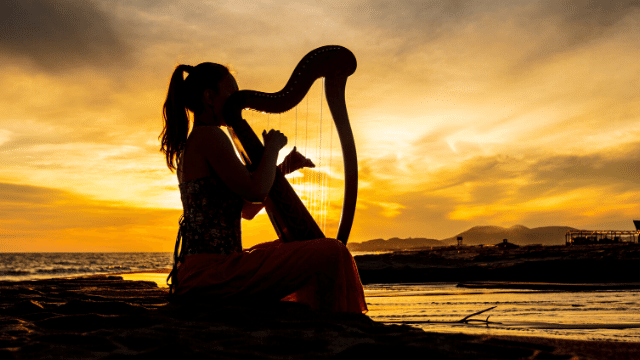The Harp is one of the most recognisable emblems in the world and is also associated with this ancient land. Our mythology, history, music and culture are known throughout the world.
We are a nation that has seen conquests and war upon its shores but has also maintained a very solid definition of what it means to be Irish.
The Harp is an integral part of that culture. We use the Harp to symbolise Ireland. It is used on Irish products and cultural movements. From the establishment of the Irish Free State in Ireland in 1922.
The Harp was chosen to become the symbol of the newly formed Irish Government, The Harp was also emblazoned on the Green Irish Flag that preceded The Tricolour.
Ireland is the only country in the world that has a musical instrument as one of its national symbols
A brief history of the harp
The Harp is an ancient and historic stringed instrument that features in our long and dramatic history and within our ancient mythology. The harp is an ancient stringed instrument.
There is evidence of the harp being used to enchant listeries as far back as 3000 BCE. The harp was used throughout the ancient world Asia, Africa and Europe all had their own version of this ancient instrument.
The harp came in major popularity in Medieval Europe. Its romantic notes enchanting the Royal Courts of Europe.
The Harp evolved for its ancient origins and has adapted with the cultures that have embraced it. In Ireland the harp has been mentioned in ancient Irish literature as far back as the 6th century.
The modern version of the Harp used in Ireland today is referred to as the Celtic Harp. Harps are very expensive to purchase but have become very popular again in recent years, the harp has even been electrified.
The Celtic harp is a square harp, which has wire strings.
To become proficient is very difficult and takes many years of dedication to master this ancient instrument. The harp is usually associated with the ruling class or royalty and has also become deeply associated with romance and traditional music.
The earliest harps that we know of were carved out of a single piece of wood, usually willow.
The strings were tightened and plucked with players fingernails. In contrast the modern harps we see today have gut strings and made of pieces of wood glued to gether.
The harp is played held against the right shoulder. Left hand plays the lower strings and the right hand plays the upper strings.
The Harp in Politics

The Harp has been used as a powerful symbol of the Irish for centuries. In ancient Irish cultural societies, tribes or clans known as Tuatha, each would have had a Harpist play at the most important events in their society. These events would have been a part of sacred rites and rituals that government our ancient belief systems.
These rites of passage and saved events would have included everything from marriage to the most important event death. Having a Harpist would have been the ultimate symbol of power and wealth.
Ireland has used the Harp as a symbol of self identity for centuries. James I & VI used the harp to represent the Island of Ireland in his Royal standards.
The Harp features on the Provincial flag of the kingdom on Leinster. The Harp features on some of our most important documents and official correspondence.
Documents of national importance such as the Presidential Seal and Standard feature the Harp. Most important, the Harp adorns The Irish Constitution. The Harp has also featured in Ireland’s bloodiest event. The unofficial Irish Flag used in the 1798 Rebellion was a green flag adorned with a golden Harp.
This Flag was also raised during Ireland Easter Rising of 1916.
When rebel forces took the GPO (General Post Office) on O’Connell Street in Dublin, it became the rebel headquarters and both the green and Tricolour flags were hoisted above the GPO during The 1916 Rising.
The Tricolour was raised by Gearoid O’Sullivan. This was also the site, where the Proclamation of The Irish Republic, was read for the first time by revolutionary leader, Padraig Pearse.
The Harp as a symbol of Ireland throughout the world.

The harp is the national emblem of Ireland and one of the recognisable instruments in the entire world.
When we travel the Harp travels with us as it is on the cover of Irish passports. When we shop the Harp is with us as it is on the Euro coins from Ireland.
The Irish budget airline RyanAir use it as a harp on the tail fin of their aircrafts. Guinness use the Harp as their emblem but it is inverted and they also named their first lager after the harp in 1960.
The harp first appeared on Irish coins in 1534 when Henry Vlll started to mint coins in Ireland. Basically everywhere you turn in Ireland you are bound to see a harp.
The oldest surviving Harp from Ireland’s illustrious past.
The oldest known Harp in Ireland today resides in The historic Long Room of Trinity College Dublin. It is commonly referred to as the Trinity College Harp but is also referred to as The Brian Boru Harp.
It was donated to Trinity College Dublin by William Conyngham who had provenance that linked this beautiful harp with Ireland’s famous High King Brian Boru.
Brian Buro was said to have a deep love and appreciation of music and was said to be the owner of a magnificent harp giving a legendary dream link quality to the Trinity College Harp. It is the oldest known Harp in Ireland and is dated to approximately the same era as 2 in Scotland.
The Lamont Harp and The Queen Mary Harp, that originally belonged to the infamous Scottish Monarch Mary Queen of Scots.
The Harp and its connection to the Mythological Ancient Dagda of the Tuath De Danann.

The Dagda is the father of the Irish Pantheon of Gods the Tuatha De Danann.
He is said to have resided in the sacred site of Bru na Boinne. Of all his possessions his most highly valued possession was his magical Harp named Uaithne.
It was made of wood that came from the ancient and sacred Irish Oak and it was beautifully decorated. Only the Dagda could make the Harp Sound its magical melody.
The sound of Uaithne was said to fill the listeners with the emotions of its melody.
This magical harp had the power to control the emotions of anyone who listens to it. It is said that before the infamous Battle of Moytura between the Tuath de Danann and their bitter enemies The Formorians.
The Formorians stole the magical Harp of the Dagda. The Tuath De Danann won the Battle. When it was discovered that the Harp was missing from Bru Na Boinne, The Dagda, Ogma and Lugh went to retrieve the Harp from The Formorians.
They eventually found the disused castle where the defeated Formorian had retreated to.
The 3 members of the Tuath De Danann were outnumbered by The Formorians who were sleeping as the Harp they had stolen hung on the cold stone wall. The Dagda put out his arms and gently called to Uaithne who dutifully went to the arms of his rightful owner The Dagda.
As the sleeping Formorians woke the Dagda obliged the suggestion of Lugh and played the Harp. Controlling the emotion of The Formorians making them laugh, weep and eventually sleep. The hordes of Formorians drifted off into a deep sleep. The Dagda, Ogma and Lugh were then able to make their escape from a very dangerous situation. The precious HarP was never stolen again.

